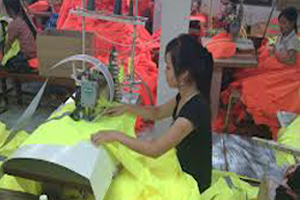
Vietnam garment industry hit by low-priced products from other countries
YarnsandFibers News Bureau 2014-01-29 11:45:00 – VietnamVietnamese garment exports growth is expected to be lower this year, with the target being only 12 percent, compared to 18 percent last year, according to the Vietnam Textile and Garment Association due to rising labor costs and heavy reliance on imported raw materials.
According to Pham Xuan Hong, the chairman of the association, Vietnam is facing ferocious competition from low-priced products from other countries, including Bangladesh, which offer lower selling prices due to their lower labor costs.
Bangladesh has among the lowest labor costs in Asia, with workers getting average monthly salaries of US$70-100, or just one third of that in Vietnam also it produces more raw materials for the garment industry than Vietnam, which also makes its products more competitive, Hong said.
A report on the Vietnamese government website last year said that the garment industry imports 70 percent of feedstock.
Industry insiders said Vietnam are highly dependent on Chinese raw materials.
Local cotton production, for instance, is only 5,000 tons, enough to meet just 1 percent of the demand, while cloth production is estimated at less than 1 billion meters, or 10 percent of the industry’s needs, according to the association.
The heavy reliance on import of raw materials causes great difficulty for garment producers. When they receive too many orders, foreign suppliers do not provide materials in time. Sometimes they delay delivery by one or two months, which affects their production, said the head of a garment company in Hung Yen Province.
Garment companies cannot deliver to importers on schedule, affecting their prestige. They even lose customers. But it is not easy to reduce imports since the domestic industry is still undeveloped.
Many textile and dyeing businesses are refused licenses everywhere they go since authorities are afraid of environmental pollution, Le Quang Hung, chairman of the Saigon Garment Production and Commerce JSC, said. Hence, some government policies are needed.
Cambodia has also become a rival to Vietnam since the US has granted it most favored nation status, meaning Cambodian garments enjoy zero tariff when exported to the US.
Lower export tax and labor costs in Cambodia are also important factors, Phung Dinh Ngo, head of garment producer Hoa Binh, said.
Vietnamese garment producers expect the Trans-Pacific Partnership (TPP) that it is set for signing this year to boost their export prospects. But things may not be so straightforward.
Le Tien Truong, vice chairman of the Vietnam Garment and Textile Group, said that to benefit from preferential tariffs in the US market, exporters would also need to meet the TPP’s requirements on the origins of raw materials. Vietnam’s garment industry imports most of its raw material needs from non-TPP members, mainly China, meaning it cannot meet the requirements.
In fact, Vietnam should have beefed up production of materials to benefit from the TPP, of which the "yarn forward" rule requires clothing to be made from yarn and fabric manufactured in one of the free trade partner nations to qualify for duty-free treatment, Truong said.
The most important task now for Vietnam garment producers is to improve quality to boost their competitiveness. As, there are no indications seen of foreign investors would expand investments in Vietnam to make use of the TPP. Moreover Vietnamese garments are subject to an export tax of around 17 percent.
Market Intelligence
Ask for free sample Report

experience
Customer Base
dedicated team
Countries Served Worldwide









